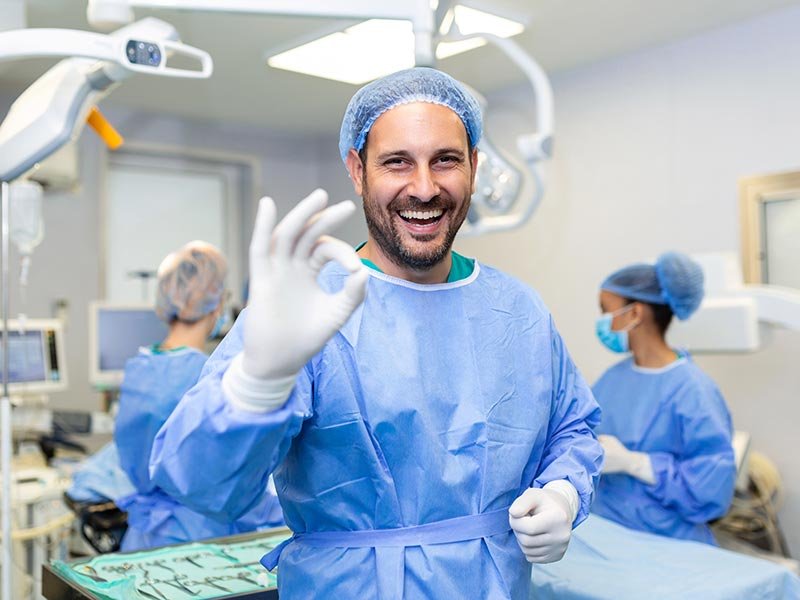Plastic Surgery Marketing
The Modern Aesthetic Patient
Composed and edited by Ferminius
This article by Growth Marketing Studios presents a comprehensive roadmap for building trust and accelerating growth in plastic surgery practices through a digital-first, data-driven approach. From understanding the psychographics of the modern aesthetic patient to constructing high-conversion websites, the content explores foundational strategies for marketing, branding, reputation management, and content development—aligned with today’s hyper-competitive and rapidly evolving aesthetic landscape.

Table of Contents
Building a Foundation of Trust for Your Plastic Surgery Practice
At Growth Marketing Studios, our philosophy is simple: We don’t guess. We scale. But scaling doesn’t start with aggressive advertising; it starts with a rock-solid foundation.
Good plastic surgery marketing relies on knowing the patient well. It also requires a strong online presence for surgeons that builds trust.
This article explains the key elements every practice must master. It covers understanding patient motivations and creating important digital assets. These assets will be the foundation of your growth strategy.
The Evolving Landscape of Aesthetic Medicine
The market for plastic and cosmetic surgery shows a clear contrast. It is growing fast but is also very competitive. Navigating this environment requires a strategic pivot away from outdated marketing methodologies toward a digital-first, data-driven approach. The professionalization of the industry further raises the stakes, demanding that practices operate as sophisticated business enterprises to thrive.
Market Dynamics: Growth Meets Hyper-Competition
The global cosmetic surgery market is experiencing a period of robust expansion, with forecasts projecting a valuation of $46 billion by 2026. This growth is driven by a mix of strong social and technological factors. More people accept aesthetic procedures now.
There are also ongoing improvements in surgical and non-surgical techniques. These advancements provide safer and more effective results. In the United States alone, the industry represents a significant economic force, valued at approximately $24.3 billion and employing over 86,000 individuals as of 2024.
However, this lucrative growth has not gone unnoticed. It has attracted a substantial influx of providers, leading to a commensurate rise in competition.
The marketplace is now densely populated, creating a fiercely competitive environment where sophisticated marketing and operational efficiency are no longer optional advantages but essential prerequisites for survival and growth. Practices that do not use a smart, forward-looking plan for getting and keeping patients may fall behind. They risk being outdone by quicker and more business-savvy competitors.
The Digital Paradigm Shift
The fundamental nature of marketing in aesthetic medicine has undergone a definitive transformation, shifting from a reliance on traditional, offline channels to a digital-first model. This paradigm shift is not a matter of trend but a strategic response to changes in consumer behavior and technological capability. At Growth Marketing Studios, we harness two core drivers that underpin this evolution:
Precision Targeting
Digital marketing channels offer an unparalleled ability to target potential patients with granular accuracy. Clinics can segment audiences based on specific demographics, geographic locations, expressed interests, and online behaviors. This precision ensures that marketing investments are directed toward individuals most likely to be interested in the practice’s services, dramatically increasing efficiency.

Measurable Return on Investment (ROI)
A primary limitation of traditional advertising is the difficulty in quantifying its impact. In contrast, digital marketing provides a wealth of concrete data on campaign performance. Every click, website visit, and consultation request can be tracked and attributed to a specific marketing channel or campaign.
This allows for the precise calculation of metrics like Patient Acquisition Cost (PAC) and ROI, enabling the data-driven systems we build for our clients. The perceived effectiveness of this model is evidenced by the fact that digital ad spending saw a 12.2% increase even during the economic uncertainty of the 2020 pandemic.
The Professionalization of the Practice
Concurrent with the digital shift is a trend toward the increasing professionalization of plastic surgery practices. Many clinics now operate as highly sophisticated business entities, with some even attracting private equity investment.
This “confluence between cosmetic surgery and entrepreneurship” elevates the standard for business operations, patient experience, and, most notably, marketing. An ad-hoc, reactive approach is insufficient in a market where competitors are executing comprehensive, data-informed growth strategies. This new reality demands that practice leaders adopt a strategic, systematic, and analytical framework for their
Patient Acquisition Strategy
The Modern Plastic Surgery Patient: A Psychographic and Demographic Analysis
A successful growth strategy begins and ends with the patient. Understanding the complex web of motivations, behavioral patterns, and cosmetic surgery patient demographics is the most critical element of effective marketing. This section breaks down the “who” and the “why.” It goes beyond simple assumptions to give a clear and useful picture of the target audience.
The decision to pursue cosmetic surgery is deeply personal and multifactorial. To connect with potential patients, marketing messages must resonate with their underlying psychological drivers. Research reveals several key motivations that extend far beyond simple vanity:
Self-Esteem and Confidence:
The most prevalent driver is the desire to enhance self-confidence and feel more positive about one’s appearance. Academic studies have consistently shown a correlation between lower self-esteem, lower life satisfaction, and a greater likelihood of considering cosmetic surgery.
Patients are subject to significant pressure to conform to prevailing beauty standards, which are increasingly defined and amplified by social media platforms like Instagram and TikTok
A potent and relatively new motivator is the “Zoom Effect,” born from the rise of remote work and video conferencing, which has heightened awareness of perceived flaws and driven demand for facial procedures.
Demographic Segmentation
The market for plastic surgery is not monolithic. It is composed of distinct demographic segments with varying needs and preferences. Effective marketing requires tailoring strategies to these specific groups.
- Gender: While women have traditionally constituted the vast majority of patients (between 85.5% and 92%), the male market is a rapidly expanding segment. From 2019 to 2022, the number of men undergoing minimally invasive procedures surged by an astonishing 253%.
- Age: Different age cohorts exhibit distinct procedural preferences. Younger patients (18-34) are the primary demographic for breast augmentation and rhinoplasty. The 35-50 age group is the largest consumer of botulinum toxin treatments, while the 40-54 cohort actively seeks body contouring. Despite media focus on youth, Generation X (43-58) and Baby Boomers (59-77) collectively accounted for the majority of procedures in 2022.
- Income: As elective expenses, cosmetic procedures show a strong correlation with income. Data indicates that 40% of individuals with an annual income exceeding $150,000 have undergone at least one cosmetic procedure.
The Evolving Landscape of Aesthetic Medicine
The market for plastic and cosmetic surgery shows a clear contrast. It is growing fast but is also very competitive. Navigating this environment requires a strategic pivot away from outdated marketing methodologies toward a digital-first, data-driven approach. The professionalization of the industry further raises the stakes, demanding that practices operate as sophisticated business enterprises to thrive.
Behavioral Factors
Understanding how and where patients conduct their research is fundamental. The patient journey almost invariably begins online.
Prospective patients overwhelmingly use search engines and online review platforms to research procedures and vet surgeons. Younger demographics (18-29) are significantly more likely to research through social media channels (41%) compared to older cohorts (11%). This behavioral data dictates the optimal channel mix Growth Marketing Studios employs to reach different patient groups.
The "Authentic Enhancement" Paradox
A nuanced examination of patient motivations reveals a paradox. On one hand, many patients are driven by the desire to align with social media beauty standards. On the other, a growing movement values individuality and “maintaining ethnic identity“. A one-size-fits-all marketing message risks alienating one of these groups.
To address this, a clinic’s marketing must be sophisticated enough to appeal to both sensibilities. Messaging should be framed around empowerment and individuality, such as becoming “the most confident version of yourself.” This approach, which we champion at Growth Marketing Studios, builds broader appeal and deeper trust.
Patient Demographics and Motivations by Popular Procedure
| Procedure | Primary Age Group | Primary Gender | Key Motivations (Psychographics) | Dominant Information Channels |
|---|---|---|---|---|
| Rhinoplasty | 18–34 | Female/Male | "Zoom Effect," social media beauty standards, desire to correct long-standing insecurity | TikTok, Instagram, Google Search |
| Breast Augmentation | 18–34 | Female | Enhance self-confidence, improve body proportions, post-pregnancy changes | Instagram, Facebook, RealSelf |
| Liposuction | 40–54 | Female/Male | Body contouring, address stubborn fat deposits, maintain appearance | Google Search, Instagram, Facebook |
| Facelift | 55+ (Baby Boomers) | Female/Male | Reverse signs of aging, look younger and more refreshed, professional competitiveness | Google Search, Facebook, Physician Referrals |
| Botulinum Toxin | 35–50 | Female/Male | Preventative anti-aging, reduce fine lines and wrinkles, non-invasive "quick fix" | Instagram, Facebook, Email Marketing |
The Digital Clinic: Architecting a High-Conversion Web Presence
In the modern healthcare landscape, the practice website is unequivocally the most critical marketing asset. It serves as the digital “storefront” and central hub for all marketing activities.
For most potential patients, their first impression of a practice comes from the homepage, not by walking in. This initial digital experience is profoundly influential, shaping up to 97% of consumer decisions. The systems we build at Growth Marketing Studios are designed not as passive online brochures, but as an active, 24/7
High-conversion website
Built to be a patient acquisition and education machine.
- Design and User Experience (UX): The aesthetic quality must mirror the high-end, professional nature of the services offered.
- Mobile-First and Responsive: A website that is not optimized for smartphones and tablets gives a bad user experience. It is also penalized by Google’s search algorithms.
- Technical Performance: Page load speed is a critical factor. Even a few seconds of delay can cause a potential patient to abandon the site for a competitor’s.
- Conversion Architecture: The website should be designed to help visitors schedule a consultation. Use clear Calls-to-Action (CTAs), easy-to-find contact forms, and online scheduling tools.
High-Impact Content Pages
- Procedure/Service Pages: Each primary procedure must have its own dedicated, comprehensive page written in clear, jargon-free language. This transparency is vital for managing patient expectations and building trust.
- The Before-and-After Gallery: This is arguably the single most powerful marketing tool available. An effective gallery is an interactive tool.
- It helps visitors filter results by procedure. It is also optimized for search engines (SEO). This helps the practice rank higher in Google Image Search.
Effective landing pages for plastic surgery are essential. A common and costly error in digital advertising is directing paid traffic to a generic homepage.
For every paid ad campaign, Growth Marketing Studios creates a custom landing page. This page focuses on converting visitors for the specific procedure shown in the ad. This dramatically increases the probability of converting an expensive click into a valuable lead.

The Trust Economy: Mastering Online
Reputation and Social Proof
In the high-stakes field of plastic surgery, trust is the ultimate currency. In the digital age, online reviews and social proof primarily define this reputation. Mastering reputation management is a fundamental business imperative for growth and risk management.
The Primacy of Patient Reviews
A surprising 80% of patients read online reviews before making an appointment. Additionally, 94% say that reviews are very important. A robust portfolio of recent, positive patient reviews serves as powerful social proof, validating a surgeon’s expertise.
Reputation and SEO Synergy
Online reviews are very important for plastic surgery SEO. They help build a strong online presence.
A steady flow of positive reviews shows Google that a business is good and trustworthy. For a competitive digital presence for plastic surgeons, this makes reviews one of the top three factors for Local SEO. This creates a powerful feedback loop: more reviews lead to higher rankings, which leads to more new patients.
Systematizing Review Generation
Review generation cannot be left to chance. A proactive, systematic, and automated approach is required.
At Growth Marketing Studios, we use a special patient review system. This system works with software like rater8, myPracticeReputation, and RepuGen.
It connects to a practice’s EMR/PMS. This helps automate review requests through email and SMS. As a result, practices get a steady stream of valuable feedback.
Managing Your Digital Footprint
-Key Platforms: It is essential to claim, optimize, and actively monitor profiles on Google Business Profile, Healthgrades, Vitals, RealSelf, and Yelp.
-Google Business Profile (GBP) Optimization: As the most prominent platform for local search, the GBP must be fully completed with detailed service descriptions, high-quality photos, and meticulously accurate Name, Address, and Phone (NAP) information.
-Responding to Reviews: A best practice strongly endorsed by Google is to respond to ALL new reviews in a timely and professional manner. Positive reviews should be met with personalized thanks. Negative reviews require a calm, empathetic, and HIPAA-compliant response that moves the conversation offline.
Content as a Cornerstone of Authority and Trust
Effective content marketing for surgeons is a fundamental tool for building authority, educating patients, and managing expectations. For a high-anxiety purchase like cosmetic surgery, content is key to building trust. This trust helps turn a researcher into a patient.
Adhering to Google's E-E-A-T Standard
For medical topics, Google’s algorithms place immense importance on E-E-A-T: Experience, Expertise, Authoritativeness, and Trustworthiness. All clinical content must be demonstrably expert-led, factually accurate, and transparent, ideally written or reviewed by a qualified surgeon.
A Full-Funnel Content Strategy
An effective content strategy meets potential patients at every stage of their journey.
-Middle of Funnel (MoF): Help potential patients evaluate options with in-depth procedure pages and guides.
-Bottom of Funnel (BoF): Drive conversions with highly optimized service and location-specific pages targeting searches like “Best Facelift Surgeon in Miami”.
Key Content FormatsTop of Funnel (ToF): Attract a broad audience with educational blog posts that answer general questions.
-Educational Blogs: A consistently updated blog is the workhorse of a content marketing strategy, serving as a powerful engine for SEO and establishing the surgeon as a trusted authority.
-Video Content: Video is the most engaging form of online content, perfect for procedure explanations, Q&A sessions, and powerful patient testimonials.
-In-depth Guides & eBooks: High-value, downloadable assets offered in exchange for an email address (a “lead magnet”) allow the practice to capture contact information for further nurturing.
Content as a Risk Mitigation Tool
A clear and open content strategy is a strong tool. It helps reduce risks for both the patient and the practice. Detailed content that honestly discusses benefits, realistic outcomes, and potential complications manages patient expectations from the start.
From a legal and ethical view, this library of content shows that the practice works hard to educate patients. This builds trust and strengthens the practice’s legal and ethical standing.
Let’s Map Your Growth.
Tell us what stage your clinic is in—and where you want it to be.
Whether you’re optimizing lead quality or expanding into new regions, we partner with practices across every phase of growth. This brief form gives us the context we need to understand your priorities and challenges. From there, we’ll match you with a strategist who speaks your language, respects your goals, and knows how to turn vision into measurable outcomes.
Let’s chart a path that’s data-backed, scalable, and built for real impact.
Give us a call
305-606-0395
Message us
support@growthmarketingstudios.com
